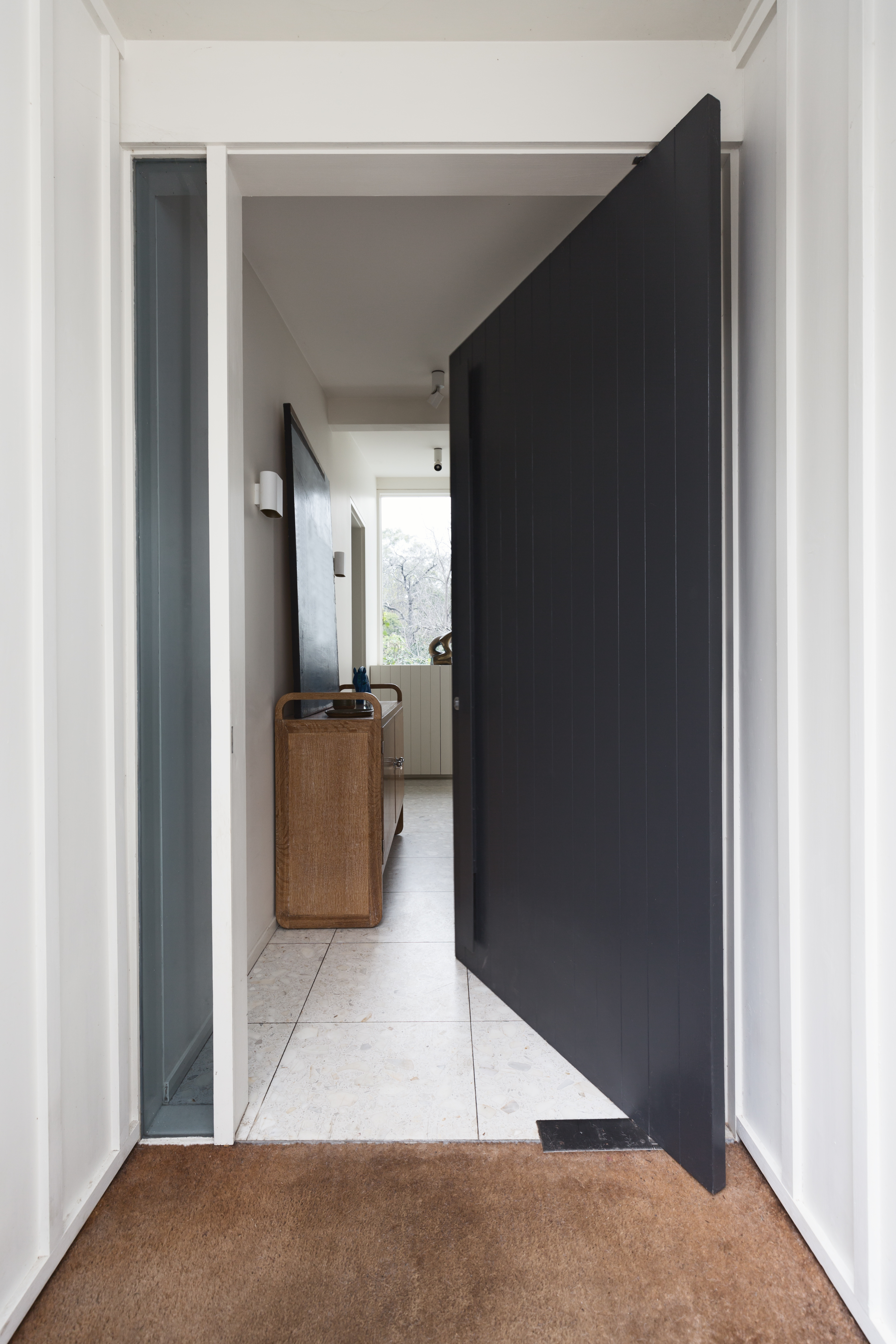
Pivot doors are most often found as front doors as an architectural feature. They are often much larger than a regular hinged door, taller as well as wider. Unlike a hinged door which only swings in one direction, a pivot door often is able to swing both inwards and outwards.
And while they are usually beautiful to look at and to use, they are usually extremely draughty doors.
It is these very features that make pivot doors quite challenging to draught proof.
Here is some information which you may find helpful.
What Is A Pivot Door:
A pivot door is suspended on points nearer to one end of the door on the top and the bottom. There are no hinges. The door pivots about those points to open and close. Generally, pivot doors are found on more modern buildings or renovations and are usually of generous proportions, somewhat larger than a regular hinged front door.
Because the door pivots about a point near to but not on the end of the door, as the main part of the door moves one way, the tail of the door moves in the opposite way.
Pivot Door Preparation:
- Some Pivot Doors swing both ways. By that I mean they swing open inwards and can also swing open outwards. Doors like this are not possible to draught proof using aftermarket components. If the seals are not already built into the door system itself then the only option is to decide in which direction you would prefer the door to operate. Choose one. Normally residential external doors open inwards. Commercial external doors normally swing outwards.
- Usually it’s not possible to draught proof a pivot door quite as well as a hinged door but still, great gains can usually be made over the existing one.
- We do not consider stick-on weather stripping to be “draught proofing”.
- Sometimes pivot doors are fitted with some unusual latching hardware. You really need a positive latch that will firmly latch the door shut. A regular door handle with a latch is ideal. If there is also a separate dead-bolt or dead-latch then they should engage in the same plane as the other door latch. That is, you should not have to push the door further in order to engage the locking mechanism. Attention to detail by the installer of the door furniture is required.
- Our experience is that pivot doors are often an architectural statement and as such aesthetics can play a large role in what treatments are visually acceptable and which are not. We only present here components and procedures that will have the greatest likelihood of actually working well in the long term. Individuals must gauge the aesthetic suitability of these components for themselves.
Let’s assume that your Swing Door swings open inwards. In the discussion below, if yours swings outwards simply swap inside for outside and vice versa.
Pivot Door Draught Proofing:
The first step is to consider a perimeter seal. This is going to treat the Latch Side of the pivot door, the opposite side of the door (which we normally call the hinge side but in this case, we will call the Pivot Side) and the head of the door. The trickiest is the head and we will consider a couple of options for this.
Perimeter Seal:
- Latch Side Perimeter Seal: As your door opens inwards, the latch side perimeter seal must fit onto the door jamb on the outside of the door. Perimeter seals such as Draught Dodgers for Doors or the RP78 acoustic seal are good choices for this. The idea is that, as your door closes, the face of the door along the latch side will rest gently onto the seal. Airtight! This is where it’s important that if you have 2 latches on the door that they latch evenly together. Having to shove the door harder into the seal in order to lock it will not be a pleasant action.
- Pivot Side Perimeter Seal: The nature of a Pivot Door is that as the Latch Side swings inwards, the Pivot Side swings outward. This means that the Pivot Side perimeter seal must be fitted on the inside. It’s the same component as used for the Latch Side but on the Pivot Side it must be fitted inside. Again, as the door closes the Pivot Side of the door will swing back in and rest gently onto the seal. Airtight!
- Head Perimeter Seal: As we already know, while most of the door swings inwards, there is a smaller section of the door on the Pivot Side that actually moves outward. This means that a regular style perimeter seal on the head cannot stretch completely across the head jamb as is the case with a hinged door. The section of seal on the outside must stretch from the latch side to near to but not quite onto the actual pivot point. The easiest way to know where to stop the head perimeter seal is to open the door and draw a line on the top jamb along the face of the door. The top perimeter seal must not encroach that line otherwise it will be hindering the door from opening. Follow the same method for determining the length of perimeter seal to fix on the inside at the Pivot Side of the head. This will be a small piece. Note that this method is NOT airtight. Clearly, air flow can happen between the two pieces of perimeter seal. Also, small pieces of self adhesive components are more likely to have the adhesive fail therefore alternative fixing methods should be considered.
- Head Seal Alternative 1: An alternative to the use of a traditional perimeter seal on the head is to use components that are normally reserved for the bottom of doors. We can consider that the head of a Swing Door is equivalent to the bottom of a Swing Door. One such component is a brush seal. Fixing a brush seal to the top face of the door such that the tip of the bristles rub on the head of the jamb is one potential way to treat the head in one piece. There are a couple of things to consider if using a brush on the top face of the door. Firstly, the actual pivot hardware sometimes sits proud of the surrounding jamb. A brush is going to have to conform around the hardware (usually an oblong steel plate). A longer bristle brush is better able to do this than a short bristle brush. Therefore consider the RP15 (25mm brush) or the RP57 (50mm brush) and consider screw fixing the aluminium carrier onto the door to prevent adhesive failure. The second consideration is that the brush may not be able to go fully end to end. The reason is that as the door opens, the outer edge of the Latch Side gets closer to the latch side jamb and the inside edge of the Pivot Side likewise gets a bit closer to the pivot side jamb. You can fit the brush on whichever side you prefer but take care that it will clear the jamb as the door opens. If you have fitted a perimeter seal to the Latch Side then fitting the brush on the outside from the jamb on the Pivot Side through to the Latch Side perimeter seal will provide a great seal and is guaranteed to clear the jamb on the Latch Side.
- Head Seal Alternative 2: Another excellent bottom treatment that can and has been applied to the head is an automatic draught excluder such as the RP35. This is an excellent device for the bottom of doors and can be applied upside down to seal the top of Pivot Doors. The same consideration about ensuring it clears the jambs on each side applies. As the seal in this device retracts as the door is opened it is likely to clear any protruding hardware. The limiting factor of this device is the maximum available length which is 1220mm. Some Pivot Doors will be wider than this.
Probably you already have a pretty good idea of what’s possible for the bottom of the door.
Bottom Seal:
- Bottom Seal – Brush: As mentioned above, a brush is a possible seal for the bottom of a door. Generally speaking we try to avoid brushes for external doors because the wind can blow through a brush however sometimes there are no other viable alternatives. The brush can be fitted inside or outside. It relies on dragging over a hard floor of about the same level as that under the door.
- Bottom Seal – Sweep: Sweep seals are similar to a brush except they use a hard rubber blade that drags on the floor. Usually these are best where they can make on a tread plate that is higher than the surrounding floor surfaces. An RP26 is a great example of a heavy duty sweep seal. Tread plates include the RP4B and the RP95. The sweep seal can be fitted inside or outside.
- An automatic draught excluder is a great option provided that your door is not too wide. The RP35 is usually a great choice. This type of draught excluder can only be fitted outside.
People Also Ask:
⇒ What is the difference between a pivot door and a hinged door?
The main difference between a pivot door and a swing door is the way they are hinged and the movement they make when being opened or closed.
Hinged doors are more traditional and functional doors. Hinged doors are the most common type of door found in buildings, homes, and offices. They are hinged on one side and swing open on a horizontal axis, opening in just one direction.
A pivot door rotates on a pivot hinge, located at the top and bottom of the door. Pivot doors tend to be larger and heavier than hinged doors. Pivot doors are often used for entrances, closets, or shower enclosures, and they can be either single or double doors. Pivot doors have the advantage of being able to swing in both directions and can provide a more seamless connection between indoor and outdoor spaces. Pivot doors are ideal for larger doorways or for when you (or your architect!) want to make a statement. Beware pivot doors are much more challenging to draught-proof
⇒ How do pivot doors open and close?
Pivot doors typically open and close by rotating on a central pivot point. Unlike traditional hinged doors, pivot doors do not swing on a hinge, but rather rotate around a vertical axis. This means pivot doors can open outwards as well as inwards.
⇒ Are pivot doors easy to maintain?
Yes, pivot doors are generally easy to maintain. They can be cleaned like any other door and require little in the way of special maintenance. The pivots will need to be lubricated occasionally to keep the door operating smoothly.
What’s Next?
We hope this article has helped you learn how to use simple ways to save on your utility bill. This in turn will help you on your energy and thermal efficiency retrofit journey to make your home more comfortable all year round, and reduce your costs and carbon emissions.
Next, explore What is a Threadplate?
If you found this article helpful, then please subscribe to our YouTube Channel. You’ll find many more helpful “How To” videos there. You can also follow us on Facebook and Instagram to stay in the loop. For more great information on how to make your home more energy and thermally efficient subscribe NOW to ecoBites. ecoBites are free bite size chunks of the latest energy efficiency information making it quick and easy for you to absorb.

Make your pivot
door draught proof
You will feel the difference immediately!


Recent Comments